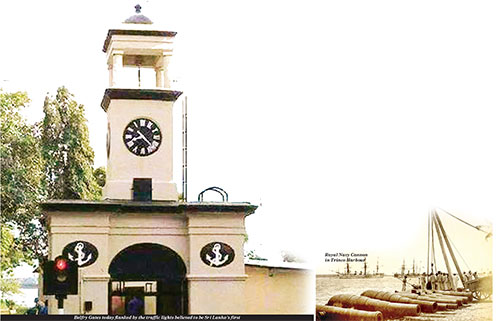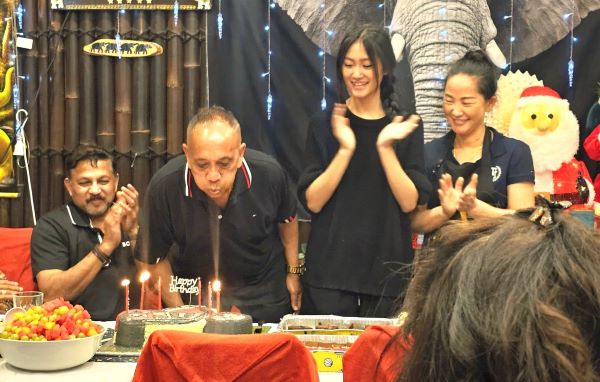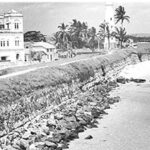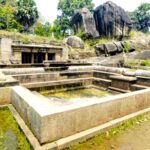Two centuries tick by on Dockyard clock-by Randima Attygalle
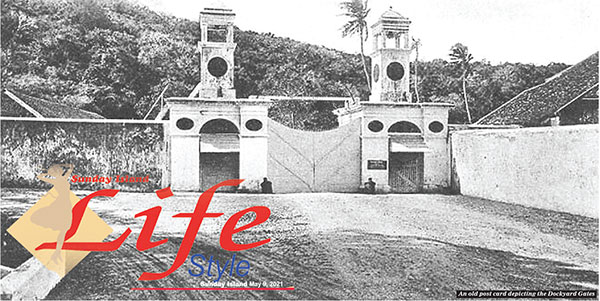
The Belfry Gate of the Trincomalee Naval Dockyard, a national architectural monument, is unknown to many. The once twin-towered belfry is now a single tower with its twin long gone. It has served as loyal timekeeper for sailors in the dockyard for 200 years and continues to do so
Source:Island
The strategically located natural deep water harbour in Trincomalee has been coveted by traders and colonists since ancient times. The earliest reference to this port of call once known as ‘Gokanna’ is found in Mahavamsa – the great chronicle of Sri Lanka. During the colonial days, Trincomalee or Trinco as it’s commonly called, was occupied by the Portuguese, Dutch, French and the British. The fort which was built by the Portuguese to keep rival sea faring nations at bay was expanded by the Dutch.
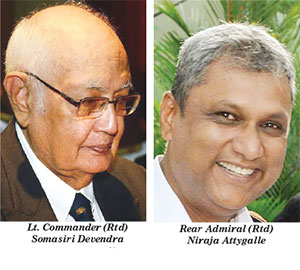 The British captured Trincomalee from the Dutch in 1795 during the Napoleonic Wars. Under the Treaty of Amiens of 1802, the Dutch ceded Ceylon to the British. H.A Colgate in his, The Royal Navy and Trincomalee- the history of their connection (The Ceylon Journal of Historical and Social Studies, Volume 1, Issue 1) documents that ‘in the days of sail, Trincomalee owed its importance to the variations of the monsoon, the prevailing winds in the Indian Ocean. A squadron defending India had to lie to the windward of the continent. It also required a safe harbour in which to shelter during the violent weather occasioned by the change of the monsoons in October and to a less extent in April. Only Trincomalee could fulfill these conditions. Thus its use was the key to the defence of India and the inestimably valuable British trade with India and China, which passed through the adjacent seas.’
The British captured Trincomalee from the Dutch in 1795 during the Napoleonic Wars. Under the Treaty of Amiens of 1802, the Dutch ceded Ceylon to the British. H.A Colgate in his, The Royal Navy and Trincomalee- the history of their connection (The Ceylon Journal of Historical and Social Studies, Volume 1, Issue 1) documents that ‘in the days of sail, Trincomalee owed its importance to the variations of the monsoon, the prevailing winds in the Indian Ocean. A squadron defending India had to lie to the windward of the continent. It also required a safe harbour in which to shelter during the violent weather occasioned by the change of the monsoons in October and to a less extent in April. Only Trincomalee could fulfill these conditions. Thus its use was the key to the defence of India and the inestimably valuable British trade with India and China, which passed through the adjacent seas.’
The British used Trinco as an anchorage for Royal Navy ships in the Indian Ocean and when the steam powered ships were launched, the Royal Navy erected a coaling station to support bases throughout the British empire. Lieutenant Commander (Rtd) Somasiri Devendra, an authority on maritime archaeology, says that the Royal Navy constructed all its dockyard-related buildings along the coastline at the entrance to the port.
“The buildings were completed by 1812 and soon after this, the conclusion of the Napoleonic wars ended the threat to the Royal Navy from the French and the Dutch and the expansion of the dockyard was halted. Trincomalee became a backwater for most of the 19th Century with its major role being that of a coaling station. Coal was stored in bulk on old ships at anchor known as coaling hulks.”
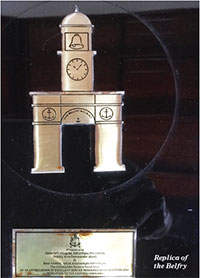 Devendra explains that all buildings within the dockyard premises were accessed through the gates popularly known as Belfry Gates. These with their twin towers were built by the British in 1821. Only one tower remains today. The exact reason for the demolition of the twin and when it was done is not established. It is presumed that one of the towers was demolished when roads were being widened for heavier traffic. “This must have been somewhere between the first and the second World Wars,” says Devendra.
Devendra explains that all buildings within the dockyard premises were accessed through the gates popularly known as Belfry Gates. These with their twin towers were built by the British in 1821. Only one tower remains today. The exact reason for the demolition of the twin and when it was done is not established. It is presumed that one of the towers was demolished when roads were being widened for heavier traffic. “This must have been somewhere between the first and the second World Wars,” says Devendra.
Most of the civilian labour working for the Navy lived outside the dockyard and the bell possibly would have been rung to mark the time of opening and closing of the gate, he said.
“The large house near the dockyard gate known as as Belfry House in which I once lived is now two houses,” he recollects. The belfry gate stands where three roads meet, marked by a traffic light believed to be the first in the country. The lights that still work well were probably needed to manage and ensure the safety of numerous vehicles carrying building material, ammunition, artillery, spare parts, and sailors and soldiers who were busy fortifying the naval dockyard and attending to the needs of ships and craft anchored in the harbour.
“When I got my driving license, there was only one set of traffic lights in Colombo – at the Kollupitiya junction. So the Trinco traffic light is probably the first in the country,” says Devendra. He adds that one of the roads controlled by these lights goes uphill to the Dutch Fort Ostenburg where the Dockyard Signal Station was situated. “It’s a steep road through forest and made of concrete, supposedly the first such road built here.”
Those who served in the Dockyard remember the belfry very well. “Traditionally, when naval officers who long served there are transferred they’re presented a replica of this landmark for display in their homes to remember their time at the dockyard,” says Rear Admiral (Rtd) Niraja Attygalle who had served many years there during his naval career.
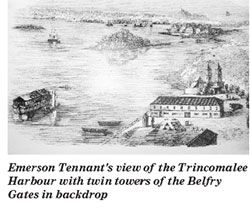 “Two hundred years is certainly a long period for a clock to tick giving the accurate time for men in white and men in overalls in workshops as well as for naval civilian workers in the dockyard. Also, the gear mechanism and electrical circuits of the traffic lights still work perfectly.”
“Two hundred years is certainly a long period for a clock to tick giving the accurate time for men in white and men in overalls in workshops as well as for naval civilian workers in the dockyard. Also, the gear mechanism and electrical circuits of the traffic lights still work perfectly.”
The responsibility of maintaining both the belfry clock and traffic lights lie with the technical staff of the dockyard and their work needs to be appreciated, says Attygalle. “Even though the original bell has not rung for years to ensure its conservation, a smaller version has taken over that duty. The quartermaster of today’s Navy Dock, standing in the shadow of the belfry, announces the time by ringing the bell as done onboard on a man-o’-war,” he says.
Although unknown to many, the Naval Dockyard Belfry which marks its bicentennial this year (its exact date of unveiling is unknown) is an iconic landmark. “This unique structure reflecting British architecture during the occupation of the Dockyard by the Royal Navy must be acknowledged for its 200-year history as part and parcel of the Dockyard fraternity,” reflects Deputy Area Commander (East), Rear Admiral Anura Danapala. “Every single Naval Officer and sailor serving today and those who have retired will undoubtedly recall with sentimental pride, the unique service the belfry has rendered over two centuries.”
“The belfy had been the timekeeper for the naval fraternity in the dockyard and may it continue to serve for several more centuries,” says the officer.
(Pic credit: Somasiri Devendra, Niraja Attygalle)
